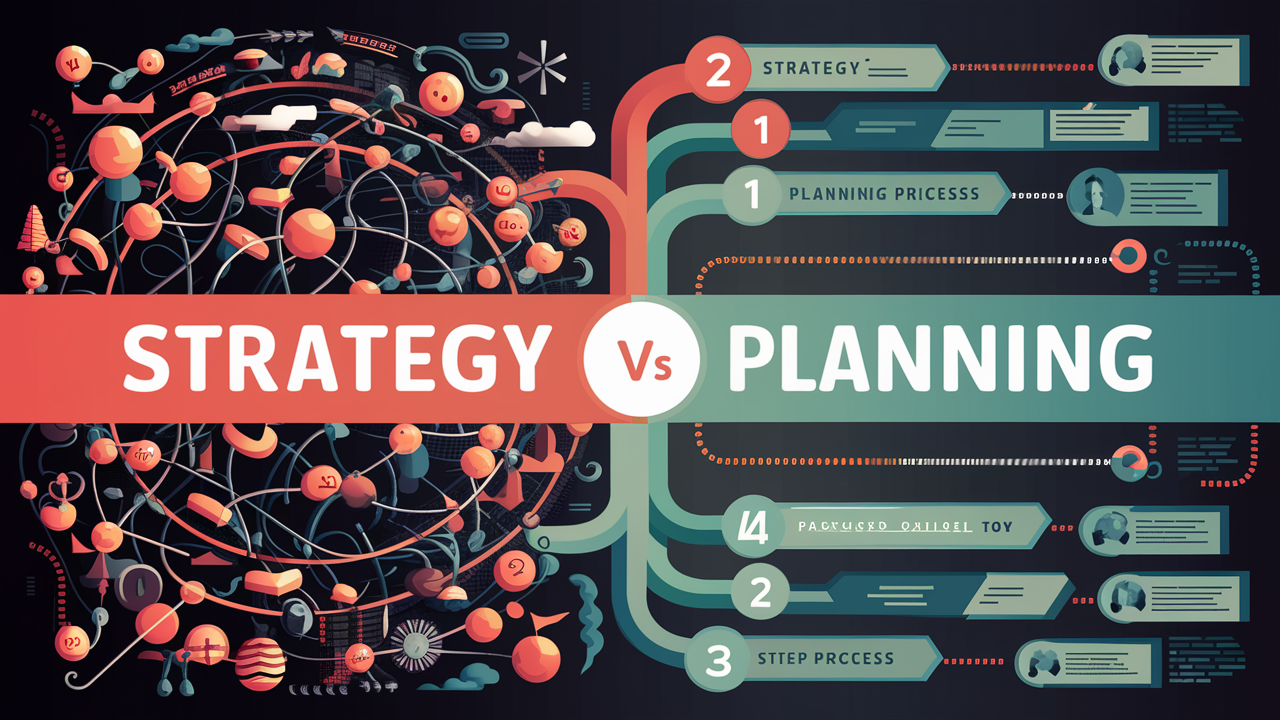In the world of business and organisational success, the terms “plan” and “strategy” are often used interchangeably, but they represent very different concepts. While both are essential for achieving goals, understanding the distinction between the two is crucial for effective leadership and decision-making. The difference between planning and strategy lies in their scope: a strategy focuses on the ‘why’ behind long-term objectives, while a plan outlines the ‘how’ through specific, actionable steps. The image above illustrates this difference by contrasting the logic of strategy with the process of planning.
In this blog, we’ll break down the key differences between planning and strategy, explain why a plan is not a strategy, and explore how the two concepts work together to drive success.
1. What is a Strategy?
Strategy is the overall logic and approach behind achieving long-term goals. It’s more than just a list of actions—it’s about making deliberate choices and understanding the big picture. A strong strategy connects the organization’s vision with its resources and focuses on creating value. As seen in the image, strategy integrates components like money, magic, means, market, and meaning to create momentum and achieve overarching objectives.
Key Elements of Strategy:
Vision-Oriented: Strategy is built around long-term goals and vision.
Integrated Logic: It connects various elements, such as resources, market needs, and unique value propositions.
Dynamic and Adaptive: Strategy often evolves as markets and circumstances change.
Focus on Competitive Advantage: It aims to differentiate an organization from its competitors.
In essence, strategy is about the “why”—why the organization chooses specific goals and how it intends to create a sustainable competitive advantage.
2. What is a Plan?
On the other hand, a plan is more about the execution process. It details the steps, activities, and timelines required to accomplish specific tasks or goals. While a strategy provides the vision and direction, the plan outlines how to get there in a structured manner.
As shown in the image, planning is a linear process that breaks down tasks department by department, assigning activities that lead to the achievement of Goal A, Goal B, and so on. It is about defining the specific actions that need to be taken.
Key Elements of Planning:
Step-by-Step Process: A plan includes tasks, deadlines, and responsibilities.
Short-Term Focus: Planning is often concerned with the “how” of achieving short-term objectives.
Execution-Oriented: It’s about putting strategy into action.
Structured and Linear: Plans tend to follow a defined sequence of activities.
Planning is crucial for implementation, but it lacks the broader context of why these actions are necessary in the grander scheme of things.
3. Why a Plan is NOT a Strategy: Understanding the Difference Between Planning and Strategy
The core difference between planning and strategy lies in their scope, purpose, and approach. While a plan helps achieve specific, often short-term objectives, a strategy focuses on long-term vision and the logic behind key decisions.
Key Differences:
Scope
Strategy is broad and encompasses long-term goals.
Planning is narrower, focusing on specific steps to achieve short-term objectives.
Purpose:
Strategy defines why the organization chooses particular paths or initiatives.
Planning outlines how to implement those paths and initiatives.
Flexibility:
Strategy is adaptable and can shift with changing market conditions.
Planning tends to be more rigid, with a structured timeline and specific tasks.
The Importance of Both:
A successful organization needs both strategy and planning to thrive. Without a strategy, a plan becomes directionless, leading to aimless execution. Without a plan, a strategy remains just a vision, with no clear path to actualization. The magic happens when the strategy defines the why and the plan provides the how, aligning them toward achieving organizational goals.
4. How Strategy and Planning Work Together
While a plan is not a strategy, both are essential components of a successful business. Here’s how they complement each other:
Strategy:
- Helps identify long-term objectives (e.g., expand into new markets, innovate product offerings).
- Focuses on making choices about resource allocation, market positioning, and competitive advantage.
- Provides a guiding framework within which planning operates, reinforcing the importance of recognizing the difference between planning and strategy for effective implementation.
Planning:
- Details the step-by-step actions required to execute the strategy.
- This highlights the difference between planning and strategy by showing how planning breaks down strategy into measurable activities, such as specific marketing campaigns, product launches, or operational improvements.
- It also ensures that everyone in the organization understands their role and responsibilities in achieving strategic goals.
5. Common Mistakes: Confusing Plans with Strategies
One of the most common business mistakes is confusing a plan with a strategy. Companies that equate the two often find themselves overly focused on day-to-day operations without a clear understanding of their competitive position or long-term goals. Here are a few pitfalls to avoid:
1. Focusing Solely on the Plan
Without a broader strategy, following a plan rigidly can lead to tactical success but strategic failure. The organization may accomplish short-term goals but miss out on long-term opportunities or market shifts.
2. Ignoring Strategic Flexibility
In rapidly changing environments, a rigid plan may no longer be effective. Without a dynamic strategy, the company may fail to adapt to new conditions, whether in technology, consumer behavior, or competitive actions.
3. Micromanaging Tasks without Vision
Leaders who focus too much on the “how” without understanding the “why” can lose sight of the bigger picture. This limits innovation and risks misallocation of resources.
Conclusion: The Need for Both Strategy and Planning
Both strategy and planning are essential, but they serve different purposes. Strategy provides the long-term direction and vision for an organization, while planning breaks down this vision into actionable, achievable steps. To succeed, leaders need to ensure that both the strategy and the plan are aligned and executed effectively.
By understanding the difference between planning and strategy, organizations can not only achieve short-term goals but also sustain long-term success.
























